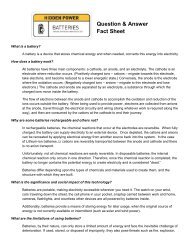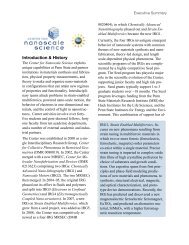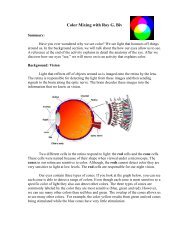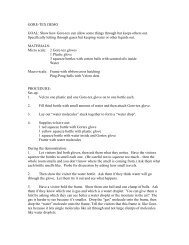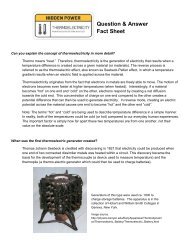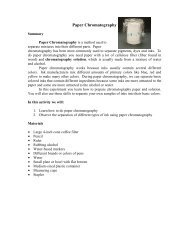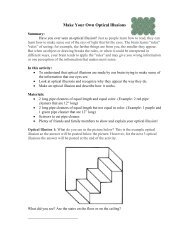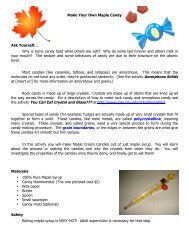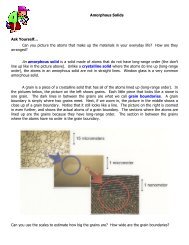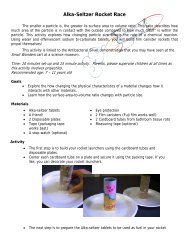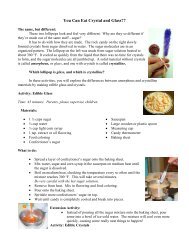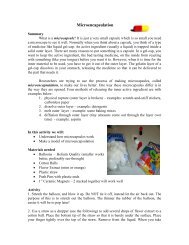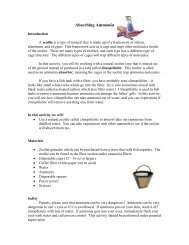Slicing Ice - the Center for Nanoscale Science
Slicing Ice - the Center for Nanoscale Science
Slicing Ice - the Center for Nanoscale Science
Create successful ePaper yourself
Turn your PDF publications into a flip-book with our unique Google optimized e-Paper software.
What’s going on?<br />
When water is in its solid phase (ice), an increase in pressure will cause <strong>the</strong> ice to melt, without<br />
any change in temperature. The wire with <strong>the</strong> weights hanging down puts pressure on <strong>the</strong> ice, which<br />
Image courtesy of www.snowcrystals.com<br />
This phase diagram<br />
of water shows <strong>the</strong><br />
temperatures and<br />
pressures at which<br />
water is a liquid, a<br />
solid or a gas. The<br />
pressure normally<br />
on <strong>the</strong> ice cube is<br />
shown by <strong>the</strong> line<br />
labeled, ”1 atm.”<br />
Starting at 1 atm at<br />
0 °C, move straight<br />
up. This represents<br />
<strong>the</strong> higher pressure<br />
put on <strong>the</strong> ice cube<br />
by <strong>the</strong> wire. Will<br />
ice stay solid or<br />
turn to a liquid?<br />
causes it to melt. As <strong>the</strong> wire moves down through <strong>the</strong> ice cube, <strong>the</strong> pressure is released above <strong>the</strong><br />
wire, and <strong>the</strong> water can re-freeze above it.<br />
<strong>Ice</strong> skaters may use this property of water. The pressure of a skate blade causes a thin film of<br />
ice under <strong>the</strong> skate to melt, making <strong>the</strong> ice slippery. When <strong>the</strong> skate moves, <strong>the</strong> ice re-freezes behind<br />
it. You also use this property of water when you make a snowball. Pressing <strong>the</strong> snow toge<strong>the</strong>r causes<br />
it to melt a little, and <strong>the</strong>n freeze back toge<strong>the</strong>r into a ball when you stop squeezing.<br />
Extensions:<br />
• Try doing this in <strong>the</strong> refrigerator or freezer. Does that change how<br />
quickly <strong>the</strong> wire moves through <strong>the</strong> ice?<br />
• What if you use o<strong>the</strong>r materials? Does it make a difference?<br />
o Try different types or thickness of wire.<br />
o Try using thread instead of wire.<br />
Connection to Nitinol:<br />
In this activity, you caused water to change phases (from solid to liquid) by putting pressure on<br />
it. Water is in different phases depending on temperature, but also depending on pressure. Putting<br />
pressure on <strong>the</strong> ice cube using <strong>the</strong> weights caused it to change to <strong>the</strong> liquid phase.<br />
Nitinol is special because it has two solid phases. At lower temperatures, it is a soft, bendable<br />
solid. At higher temperatures, it is a springy, rigid solid. Which phase it is in depends on temperature.



